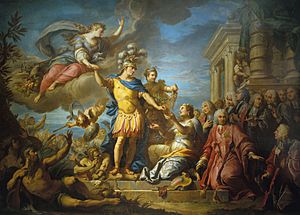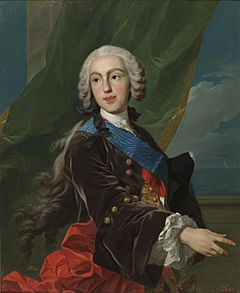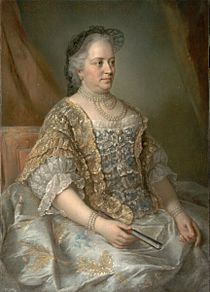Treaty of Aix-la-Chapelle (1748) facts for kids

A painting celebrating the peace by Jacques Dumont
|
|
| Context | Ends the War of the Austrian Succession |
|---|---|
| Signed | 18 October 1748 |
| Location | Free Imperial City of Aachen, Holy Roman Empire |
| Effective | 18 October 1748 |
| Parties |
|
| Language | French, Neo-Latin |
The 1748 Treaty of Aix-la-Chapelle, also known as the Treaty of Aachen, was a peace agreement. It officially ended the War of the Austrian Succession. This important treaty was signed after a big meeting, called a congress, in the city of Aachen. The congress started on April 24, 1748.
The main countries fighting in the war were Britain and France. They began talking about peace in 1746 in the Dutch city of Breda. Britain hoped to get a better deal, so they delayed the talks. When their plans didn't work out, they agreed on a first draft of the treaty on April 30, 1748. The final treaty was signed on October 18, 1748, by Britain, France, and the Dutch Republic.
After this, the terms were shown to the other countries involved in the war. They had to either accept the terms or keep fighting alone. Austria, Spain, and Sardinia had no choice but to agree. They signed their parts of the treaty separately. Later, Modena and the Republic of Genoa also joined on January 21, 1749.
Many countries were not happy with the treaty's terms. It didn't really fix the main problems that caused the war. This unhappiness led to new alliances and another big conflict, the Seven Years' War, which started in 1756.
Why the Treaty Was Needed
Peace talks between France and Britain started in August 1746. However, the Duke of Newcastle, who managed Britain's foreign policy, purposely slowed things down. He hoped that the death of Philip V of Spain would weaken the alliance between Spain and France. He also thought that a new political change in the Netherlands would make their army stronger. But these hopes did not come true. Spain's policies stayed mostly the same, and the Dutch army became weaker.

Even though France won battles in Flanders, Britain's navy was blocking French trade. This caused big money problems for France. By 1746, France's finance minister warned King Louis XV that their financial system was about to collapse. The situation got even worse after a major naval battle in October 1747. The French navy was too weak to protect their trading ships.
Meanwhile, Maria Theresa of Austria had already made peace with Bavaria in April 1745. She then made peace with Prussia in December. After that, Austria could only stay in the war because Britain gave them money. By December 1747, Austrian leaders agreed that "even a bad peace is better than starting another war." They suggested ways to end the fighting in Italy. They agreed to pull their troops out of the Duchy of Modena and Republic of Genoa. They also agreed that Spain would control Naples. They even offered land to Philip of Spain to create an Italian state for him.
In November, Britain made a deal with Russia to get 37,000 Russian soldiers. These troops arrived in Germany in February 1748. Britain was also ready to end the war. They had not made much progress in Flanders. Also, people in Britain were unhappy about how much money they were spending to help their allies. Both France and Britain were ready to make their allies accept the peace terms if needed.
On April 30, 1748, France, Britain, and the Dutch Republic signed a first agreement. This agreement included returning the Austrian Netherlands to Austria. It also meant giving back the Dutch forts that protected their border. The cities of Maastricht and Bergen op Zoom were also returned. The agreement also confirmed that Silesia would belong to Prussia. And it gave the Duchies of Parma and Guastalla to Philip of Spain. Because of this, Austria, Sardinia, Spain, Modena, and Genoa had to agree. They signed their parts of the treaty in two separate documents. These were finished on December 4, 1748, and January 21, 1749.
What the Treaty Decided

The treaty included these main points:
- All countries agreed to accept the Pragmatic Sanction of 1713. This was a rule that allowed Maria Theresa to inherit the lands of the Habsburg family.
- Austria agreed that Prussia would keep Silesia.
- Austria gave the Duchies of Parma, Piacenza, and Guastalla to Philip of Spain. He was the second oldest son of Philip V of Spain.
- Austria gave some smaller areas in Italy to Sardinia, including Vigevano.
- Austria pulled its troops out of the Duchy of Modena and the Republic of Genoa. These areas became independent again.
- France pulled its troops out of the Austrian Netherlands. It also returned the Dutch border forts, Maastricht, and Bergen op Zoom.
- Britain and France traded back lands they had captured. Britain returned Madras in India to France. France returned Louisbourg in Canada to Britain.
- Spain renewed a contract called the Asiento de Negros. This contract gave Britain the right to supply slaves to Spanish America. Britain later gave up this right in 1750 for money.
- A special group was set up to solve land disputes between French and British colonies in North America. France also agreed to make Charles Edward Stuart, a Scottish prince who wanted to be king of Britain, leave France.
What Happened Next
The treaty did not really solve the problems that started the war. Most countries were unhappy with the deals they made. They felt they had given up too much or not gained enough. This led to a big change in alliances in 1756, known as the Diplomatic Revolution. This change then led to the Seven Years' War.
Prussia gained the most from the treaty. It doubled in size and wealth by getting Silesia. Austria, on the other hand, lost the most. Maria Theresa did not see accepting the Pragmatic Sanction as a big deal. She was very upset that Britain made her give up Silesia and other lands in Italy. However, the Habsburg family survived a very difficult time. They got back the Austrian Netherlands and kept their power in Italy. Austria became stronger in the 1750s than it was in 1740.
Spain felt they did not get enough land in Italy. They also failed to get back Menorca or Gibraltar. They saw Britain's renewed trading rights in the Americas as an insult. Charles Emmanuel III of Sardinia felt he had been promised the Duchy of Parma. But he only got smaller areas from Austria. The war also showed that the Dutch Republic was no longer a major power. Their border forts were too weak against modern cannons.
Many French people did not understand how bad France's money problems were. They did not see why France had to give back the lands they won in the Austrian Netherlands. They also felt they got nothing for helping Prussia. This led to the saying "as stupid as the Peace." Many French leaders thought King Louis XV had panicked. An English writer, Horace Walpole, wondered "why the French have lost so much blood and treasure to so little purpose." After the treaty, Charles Edward Stuart, who wanted to be the British king, was arrested and sent away from France.
The weakness of the Dutch army showed that Hanover, King George II's German land, was in danger. France insisted on getting back Louisbourg in exchange for returning the Dutch forts. Capturing Louisbourg in 1745 was one of Britain's few clear successes in the war. Giving it back made people in Britain and America furious. They felt it helped the Dutch and Hanover at the expense of the American colonies.
Lord Sandwich, the main British negotiator, forgot to include some old agreements with Spain in the treaty. When he tried to fix it, Spain refused to sign. This threatened the valuable trade between the two countries. Since trade was also important to Spain, they later agreed to terms in the October 1750 Treaty of Madrid. But this was another reason why people were unhappy with the treaty.
Austria was angry at Britain for being "disloyal." In London, many people also questioned if it was worth giving so much money to Austria. They thought Prussia would be a better ally. In the 1752 Treaty of Aranjuez, Austria, Spain, and Sardinia agreed to respect each other's borders in Italy. This ended conflict in that area for almost fifty years. It allowed Maria Theresa to focus on Germany. She was determined to get Silesia back. Many felt the treaty left too many problems unsolved. So, it was seen more as a break in fighting than a true peace.
The treaty also marked the end of the First Carnatic War (1746–1748) in India.
To celebrate the signing of the treaty, the famous composer George Frideric Handel wrote special music. It was called Music for the Royal Fireworks.
Images for kids
See also
 In Spanish: Tratado de Aquisgrán (1748) para niños
In Spanish: Tratado de Aquisgrán (1748) para niños



